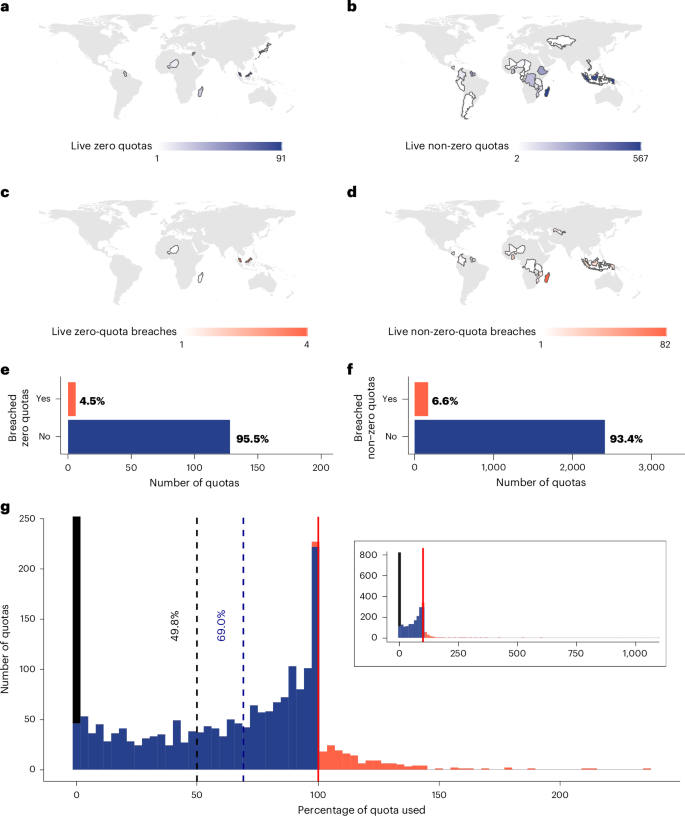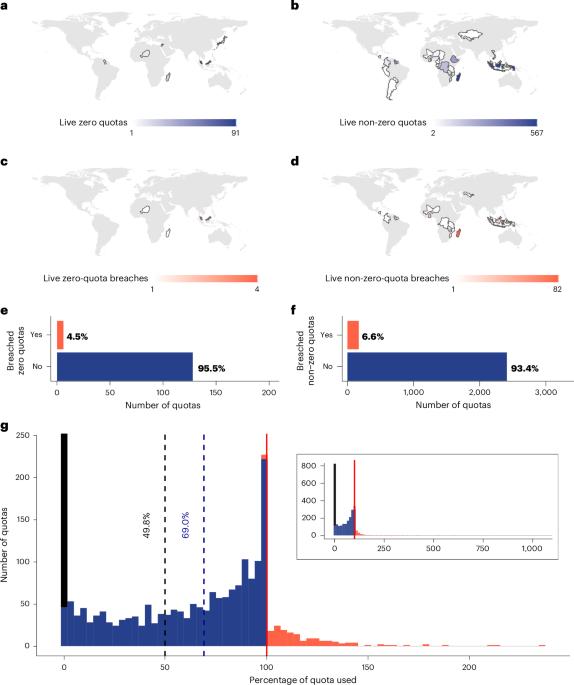International wildlife trade quotas are characterized by high compliance and coverage but insufficient adaptive management
IF 13.9
1区 生物学
Q1 ECOLOGY
引用次数: 0
Abstract
Effective management of international wildlife trade is crucial to ensure sustainability. Quotas are a common trade management tool and specify an annual number of individuals to be exported, yet at present there is no global assessment of quota coverage and compliance. Using over 7,000 country–year specific reptile quotas established under the Convention on International Trade in Endangered Species of Wild Fauna and Flora (CITES) covering 343 species, we quantify quota coverage, compliance, trade trends pre-quota and post-quota setting and whether quotas likely represent adaptive management. Quotas predominantly concerned live wild-sourced reptiles, with only 6.6% of live non-zero quotas exceeded and 4.5% of zero quotas subverted. For 62.3% of species, quotas were established higher than pre-quota trade, with traded volumes post-quota mainly unchanged or higher than pre-quota establishment, thus potentially facilitating sustainable trade. Over 38% of quota series of species remained at the same level each year, with the longest-running quotas proportionately updated the least, indicating that many quotas do not change adaptively in response to changing threats to species through time. Greater specificity in exactly what quotas cover, justification for unchanged quotas and transparency over quota determination are needed to ensure that high compliance equates to sustainable use. Analysis of more than 7,000 quotas for reptile trade from around the world identifies that few quotas are exceeded, although quotas often exceed pre-quota trade volumes, and that many quotas remain unchanged, with the longest-running quotas proportionately changing the least.


国际野生动植物贸易配额的特点是遵守率和覆盖率高,但适应性管理不足
有效管理国际野生动植物贸易对确保可持续性至关重要。配额是一种常见的贸易管理工具,规定了每年出口的个体数量,但目前还没有对配额覆盖范围和遵守情况进行全球性评估。我们利用根据《濒危野生动植物种国际贸易公约》(CITES)制定的涵盖 343 种爬行动物的 7000 多个国家年度具体配额,对配额覆盖率、合规性、配额制定前后的贸易趋势以及配额是否可能代表适应性管理进行了量化。配额主要涉及活体野生爬行动物,只有 6.6% 的活体非零配额被超过,4.5% 的零配额被破坏。62.3% 的物种配额的制定高于配额制定前的贸易量,配额制定后的贸易量主要保持不变或高于配额制定前的贸易量,因此有可能促进可持续贸易。38% 以上的物种配额系列每年都保持在同一水平上,配额持续时间最长的物种配额更新的比例最小,这表明许多配额并没有随着时间的推移发生适应性变化,以应对物种所面临的不断变化的威胁。需要更加具体地说明配额的确切覆盖范围、配额不变的理由以及配额确定的透明度,以确保高度履约等同于可持续利用。
本文章由计算机程序翻译,如有差异,请以英文原文为准。
求助全文
约1分钟内获得全文
求助全文
来源期刊

Nature ecology & evolution
Agricultural and Biological Sciences-Ecology, Evolution, Behavior and Systematics
CiteScore
22.20
自引率
2.40%
发文量
282
期刊介绍:
Nature Ecology & Evolution is interested in the full spectrum of ecological and evolutionary biology, encompassing approaches at the molecular, organismal, population, community and ecosystem levels, as well as relevant parts of the social sciences. Nature Ecology & Evolution provides a place where all researchers and policymakers interested in all aspects of life's diversity can come together to learn about the most accomplished and significant advances in the field and to discuss topical issues. An online-only monthly journal, our broad scope ensures that the research published reaches the widest possible audience of scientists.
 求助内容:
求助内容: 应助结果提醒方式:
应助结果提醒方式:


